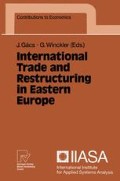Abstract
The key issue facing transition economies in Central Europe has been the initiation of economic recovery.
The author is grateful to G. Fink, R. Portes, C. Wihlborg, and S. Wright for helpful comments on the first version of the paper.
Access this chapter
Tax calculation will be finalised at checkout
Purchases are for personal use only
Preview
Unable to display preview. Download preview PDF.
References
Balassa, B. (1964) “The purchasing power doctrine: A reappraisal,” Journal of Political Economy, December.
Baldwin, R. (1969) “The case against infant-industry tariff protection,” Journal of Political Economy.
Barro, R.J., and Gordon, D.B. (1983) “Rules, discretion and reputation in a model of monetary policy,” Journal of Monetary Economics.
Bofinger, P. (1990) The Role of Monetary Policy in the Process of Economic Reform in Eastern Europe, CEPR Discussion Paper No. 457 (London: Center for Economic Policy Research).
Bohatá, M., and Fischer, M. (1992) Analýza vývoje výkonnosti prúmyslu v prúbehu transformacního procesu (Prague: ÚÚNV).
Dornbusch, R. (1990) From Stabilization to Growth, NBER Working Paper No. 3302 (Cambridge, MA: National Bureau of Economic Research).
Facts on Czechoslovak Foreign Trade (1991) (Prague: Czechoslovak Chamber of Commerce and Industry).
Fry, M.J. (1992) Monetary and Exchange Rate Policies in Poland and Other Eastern European Countries: Some Lessons from Further East (Birmingham, UK: University of Birmingham, International Finance Group).
Fry, M.J., and Nuti, D.M. (1992) “Monetary and exchange rate policies during Eastern Europe’s transition,” Oxford Review of Economic Policy, Spring.
Herr, H., Tober, S., and Westphal, S. (1991) “A strategy for economic transformation and development in Eastern Europe,” De Pecunia, No. 3, December.
Hillman, A.L. (1991) “International trade policy in the transition from socialism,” Conference “Whither Socialist Society? Economic and Social Transformation in the Soviet Union and Eastern Europe,” April 8–10, Jerusalem, in M. Keren and G. Ofer (eds.), Trials of Transition: Economic Reform in the Former Communist Bloc (Boulder, San Francisco, Oxford: Westview Press).
Hochreiter, E., and Knöbl, A. (1991) Exchange Rate Policy of Austria and Finland: Two Examples of a Peg, Discussion Papers, 191, No. 12 (Helsinki: Bank of Finland).
Hrncír, M. (1993) “The roles of foreign competition and of financial intermediation in revitalising the Czechoslovak economy,” in C.T. Summers (ed.), The Role of Competition in Economic Transition (New York: St. Martin’s Press in association with the Vienna Institute for Comparative Economic Studies).
Hughes, G., and Hare, P.G. (1992) “Industrial policy and restructuring in Eastern Europe,” Oxford Review of Economic Policy, No. 1.
Kolanda, M. (1989) Export Performance of Czechoslovak Manufacturing Firms (Prague: Institute of Foreign Trade).
Kolanda, M., and Kubista, V. (1990) Costs, Performance and Behavior of the Czechoslovak Manufacturing Enterprises on the World Markets in the 1980s (Prague: Institute of Forecasting).
Kornai, J. (1986) “The soft budget constraint,” Kyklos.
Landesmann, M. (1991) “Industrial restructuring and the reorientation of trade in Czechoslovakia,” European Economy, Special Edition No. 2.
Lepännen, S. (1992) “Finland and Austria: Two different economic policy strategies” (Helsinki: Government Institute for Economic Research).
MacDonald, R., and Taylor, P.M. (1992) “Exchange rate economics,” IMF Staff Papers, No. 1.
McKinnon, R. (1991) “Liberalising trade in a socialist economy,” in J. Williamson (ed.) Currency Convertibility in Eastern Europe (Washington, DC: Institute of International Economics).
Marin, D. (1985) “Structural change through exchange rate policy,” Weltwirtschaftliches Archiv, No. 3.
Mundell, R.A. (1962) “The appropriate use of monetary and fiscal policy for internal and external stability,” IMF Staff Papers.
National Economic Development Office (1977) International Price Competitiveness, Non-Price Factors and Export Performance (London: National Economic Development Office).
Nurkse, R. (1950) “Conditions of international monetary equilibrium,” in H.S. Ellis and L.S. Metzler (eds.) Readings in the Theory of International Trade (Philadelphia, Toronto: Blakiston Company).
Nuti, D.M. (1990) “Internal and international aspects of monetary disequilibrium in Poland,” European Economy, Special Issue, Economic Transformation in Hungary and Poland, March, No. 43.
Pekkarinen, J., Pohjola, M., and Rowthorn, B. (1992) Social Corporatism: A Superior Economic System? (Oxford: Clarendon Press5).
Pick, M. (1990) Productivity, Purchasing Power Parity, Exchange Rate (Prague: Institute of Forecasting).
PlanEcon (1992), PlanEcon Report, Nos. 16–18 (Washington, DC: PlanEcon).
Portes, R. (1990) “Introduction,” European Economy, Economic Transformation in Hungary and Poland, March, No. 43.
Rollo, J.M.C., and Stern, J. (1992) Growth and Trade Prospects for Central and Eastern Europe (London: National Economic Research Associates).
Sargent, T.J. (1986) Rational Expectations and Inflation (New York: Harper & Row).
Summers, R., and Heston, A. (1988) “A new set of international comparisons of real product and prices: Estimates for 130 countries,” Review of Income and Wealth, No. 1.
Wihlborg, C.G., and Willett, T.D. (1991) “Optimal currency areas revisited,” in C.G. Wihlborg, M. Fratianni, and T.D. Willett (eds.) Financial Regulation and Monetary Arrangements after 1992 (Amsterdam: Elsevier).
Williamson, J. (1991) The economic opening of Eastern Europe,” in J. Williamson, (ed.) Currency Convertibility in Eastern Europe (Washington, DC: Institute for International Economics).
Editor information
Editors and Affiliations
Rights and permissions
Copyright information
© 1994 Springer-Verlag Berlin Heidelberg
About this chapter
Cite this chapter
Hrnčíř, M. (1994). Economic Recovery and Foreign Exchange Rate Regime: The Case of the Czech Republic. In: Gács, J., Winckler, G. (eds) International Trade and Restructuring in Eastern Europe. Contributions to Economics. Physica, Heidelberg. https://doi.org/10.1007/978-3-662-28276-2_4
Download citation
DOI: https://doi.org/10.1007/978-3-662-28276-2_4
Publisher Name: Physica, Heidelberg
Print ISBN: 978-0-387-91480-0
Online ISBN: 978-3-662-28276-2
eBook Packages: Springer Book Archive

